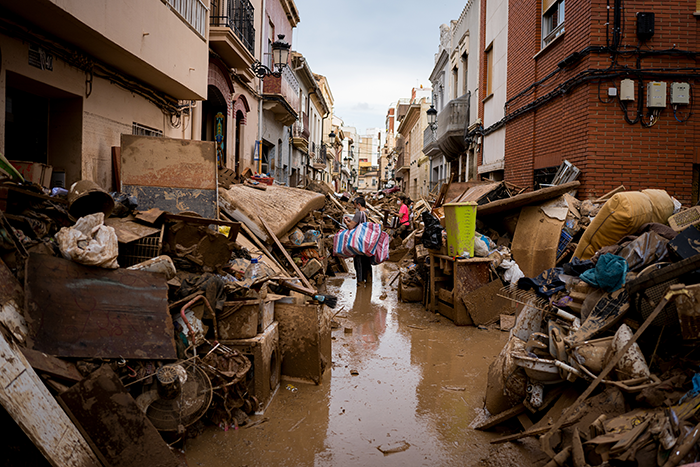Interviews / Defence and Climate Observatory
12 November 2024
Floods in Spain: Is Europe Prepared for the Increase in Water-Related Climate Disasters?

On October 19, 2024, the Valencia region in Spain was hit by massive floods, resulting in several hundred deaths and causing significant economic losses. A true trauma for Spain, which appeared unprepared for such a natural disaster, sparking anger from the population towards its local and national leaders. This tragic event raises questions about Europe’s, particularly the Mediterranean region’s, ability to cope with climate change. Could the Spanish authorities have better anticipated the extreme weather? Should we expect the emergence of water-related conflicts in Europe? How are military forces prepared for water stress? A discussion with Éléonore Duffau, a researcher at IRIS within the Climate, Energy, and Security program, where she specializes in the strategic and security issues related to climate change.
Several hundred people have died following massive floods in the Valencia region of Spain. Could this region have anticipated such a disaster? How can we understand the scale of the catastrophe and the human tragedy?
Several environmental, climatic, and political factors must be considered to understand the scale of this disaster. On the one hand, the Spanish Mediterranean coast, particularly the Valencia region, regularly experiences the meteorological phenomenon known as the “cold drop,” an isolated depression at high altitude that can cause sudden and extremely violent rainfall, sometimes lasting several days. This isolated depression encountered moisture-laden winds from the eastern Mediterranean coast, which led to the formation of storms with torrential downpours in the Mediterranean. These downpours were intensified by the very high humidity levels in the air, which can be explained by the rising air temperatures in the Mediterranean. Thus, climate change has exacerbated the scale of this cold drop, which was of rare intensity and caught both the inhabitants and the authorities off guard.
It is also important to highlight the human responsibility in this catastrophe, with, on the one hand, the exacerbation of climate vulnerabilities through land use policies and, on the other hand, a lack of responsiveness and coordination in crisis management policies. Firstly, the concentration of populations and urbanization of Mediterranean coastlines represent an additional vulnerability for residents in the face of extreme weather events. Massive urbanization (almost 40% of the coastline is built-up) worsens the consequences of extreme rainfall, especially due to soil artificialization, which hampers the land’s ability to absorb water and intensifies runoff phenomena. On the Spanish coast, which is highly urbanized and thus highly artificialized, soils have also been dried out in recent years due to droughts, increasing their impermeability. Finally, 500,000 people live in flood-prone areas in the Valencia region, illustrating a failure to take into account the risks associated with weather events. Thus, land-use planning must be reconsidered to ensure the resilience of societies in the face of these growing climatic events.
Finally, the tragic toll of these floods raises questions about the crisis management mechanisms adopted by the Valencian Autonomous Community and the Spanish government. The alerts issued by the Spanish Meteorological Institute were not taken seriously enough by the regional government, which was slow to warn residents and mobilize emergency military units (UME). As a result, the lives of many people were endangered due to these oversights. Furthermore, populations engaged in risky behaviors, such as attempting to drive their cars out of garages. Experts emphasize the lack of risk awareness among both authorities and residents. Therefore, it is crucial to develop a culture of risk among the population so that everyone understands the necessary actions to take to protect themselves and others in the event of flooding and, more broadly, in the case of climate disasters. Finally, the catastrophe highlighted tensions regarding the distribution of power between the levels of Spanish governance: the federal state and the autonomous communities, as well as between the parties in power at these levels (Spanish Socialist Workers’ Party at the national level and the People’s Party in the Valencia region). According to some observers, the scale of this catastrophe shows that the Spanish autonomous state model is not adapted to face such emergencies.
The Spanish royal family, visiting the disaster site, faced criticism from the population. To what extent can water-related climate disasters lead to tensions or conflicts?
The conflict potential of water is an increasingly important issue within geostrategic analyses, given climate change and the scarcity of the resource. Water resources can be defined as a priority, and thus water stress as a major security risk. However, even though water wars seem particularly dominant in analyses of the intersection between conflicts and water, many researchers nuance these ideas and propose a less alarmist narrative. Thus, it is highly unlikely that conventional interstate wars will be triggered by water stress, especially in Southern Europe, thanks to the European regulatory and political framework. However, the resource is at the heart of local tensions regarding its appropriation, management, or exploitation.
Conflicts over the use of water resources in Southern Europe have been documented between 2000 and 2024 by the Defence and Climate Observatory in the context of a new report on the security issues of water stress. This data collection shows an increase in the frequency and intensity of such conflicts in Southern Europe between 2000 and 2024, particularly in France, in relation to reservoirs for agriculture. In Spain, numerous dams and attempts to transfer water appear to be at the core of water-related conflicts. For example, the project to transfer water from the Tagus River to the Segura River is a significant source of tension. This ambitious engineering project, dating back to the 1980s, was designed to transport water from the Tagus River in central Spain to the Segura River in the southeast, leading to ongoing disputes between regions over water rights, environmental impacts, and the economic consequences of such a transfer. More specifically, the region of Murcia demands additional water to meet the needs of its regional tourism sector, which conflicts with the Castile-La Mancha region that wishes to prevent the transfer of water for agricultural use. Finally, dams are often criticized during protests for their negative impact on the environment and aquatic ecosystems. These demonstrations can provoke strong police repression, as seen in October 2012 in Aragon, during a protest by environmentalists and residents of the town of Artieda, who faced the expropriation of their land due to the enlargement of a water reservoir.
The Defence and Climate Observatory has just published a report on water stress in Europe and how the military is preparing for it. Have European armed forces already integrated the issue of water into their doctrine?
European armed forces on the Mediterranean coast are gradually taking into account the issues related to water stress. In France, for example, the Ministry of Armed Forces has developed a ministerial water strategy, which aims to protect water resources and anticipate disruptions to the water cycle for the health, missions, infrastructure, and equipment of the armed forces. However, the degree to which the French military has integrated water-related issues varies between external operations (OPEX) and activities within the national territory. In the first case, water management is already advanced, thanks to the experience gained in French military projection areas subjected to more challenging environmental and water conditions (Sahel, Afghanistan, Romania, Lebanon, etc.). Within the national territory, the French armed forces primarily play a key role in responding to water crises, such as droughts, floods, or wildfires. The objectives set out in the water strategy will help better understand the military’s use of water, and thus examine the scope for reducing withdrawals.
Thus, the French military, as well as the Italian, Spanish, and Portuguese armed forces, have adopted structural and holistic military strategies for water issues through policies aimed at improving infrastructure and reducing water withdrawals and consumption. In Italy, for example, the military has implemented a system to measure and monitor water consumption at military sites, alongside a strategy for the rational use of available water resources. Similarly, the Ministry of Defence launched the Caserme Verdi project in 2019 to renovate the water and energy infrastructures of 26 barracks. The Spanish Ministry of Defence has also developed a plan for the prevention and remediation of contaminated lands at military sites, addressing both surface water and groundwater issues. In Portugal, objectives demonstrate a desire to transform practices within the Ministry of Defence, such as strengthening pollutant control or reusing treated wastewater, reaching up to 50% at certain bases.
However, other countries, such as Slovenia, adhere to a less transformative and more technocentric and reactive approach to these issues. Finally, Greece presents a particular case, as little information is available on water management within the military. Paradoxically, Greece faces a critical situation regarding water resource availability but was the initiator in 2016 of a promising and relatively forward-thinking military cooperation on water management called Smart Blue Water Camp. While cooperation in water governance is common, it is rarer in the military domain, especially in OPEX, where the desire to maintain logistical autonomy prevails.

